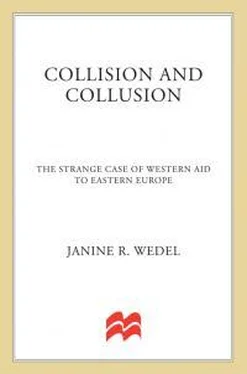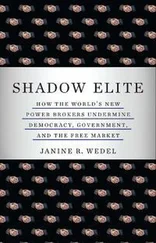COUSINS IN THE EAST
Apart from providing the West with an opportunity for major philanthropy, the collapse of communism offered it an historic opportunity to reconnect with the East. For the West, it was understandable, natural, and practical to help “our cousins.” The region’s “transition” was likened to the recovery of an ill patient with whom “we” had close cultural and historical bonds and from whom “we” had been separated only by an accident of history. The nations of Central Europe had been torn from Europe and forced into the Soviet orbit by the politics of the Cold War, not free will. There was to be “integration” and “partnership” between East and West, concepts much more easily accepted with regard to Poland, Hungary, and Czechoslovakia than, say, Africa. Psychology played a role: social critic Pascal Bruckner has observed that “Our estimation of a nation is tied in with our capacity to identify with it, to project ourselves in it.”18 Indeed, the West’s capacity to identify with the peoples of the East lent a familial feel to the aid effort. Central Europeans were European. And the timing was fortuitous: the Communist Bloc collapsed at a moment when the idea of European unity (and a push for expansion of the European Community) was gaining great momentum in the West.
Not all of the newly independent countries of the Second World were considered candidates for joining Europe. The idea of European nations as aid recipients had upset the worldview of the development community. It could not readily classify the region as either “underdeveloped” or “developed”—the traditional development scheme, which, in application, is self-legitimating.19 To resolve this ambiguity, the more “developed” countries of Poland, Hungary, and what was then Czechoslovakia were categorized almost as Western European countries that needed simply to catch up.20 On the other hand, the “underdeveloped” countries of the Balkans and southeastern Europe were hardly candidates for “partnership” or “integration.” They had fewer historical and cultural ties to the West, generally had less “developed” national economies, and were less industrialized.
The “model” countries of Poland, Hungary, and Czechoslovakia, which were to be the first of the former Bloc countries to “return to Europe,” became the primary targets of most initial Western assistance. These countries, with Western Christian traditions, could claim deep historical and cultural ties to the West and identified with the West. During the martial-law crackdown of the early 1980s, Polish psychologist Zbigniew Nęcki noted that “we compare ourselves to Western countries, the most developed ones such as the United States, Japan, France, Sweden, and the Federal Republic of Germany.”21 Bulgaria and Romania, on the other hand, although also newly freed from the Soviet orbit, had an Eastern Orthodox tradition, and were inclined to look East. Further, the considerable intellectual freedom and permission to travel that Poles and Hungarians had enjoyed since 1956 gave them closer contact with the West than Bulgarians and Romanians, whose travel and intellectual freedom had been severely restricted.
One of the West’s key criteria for prospective partners was the extent to which a particular country figured in the West’s security, political, and economic considerations. With the Soviet Union still in existence, and taking care not to annoy their giant eastern neighbor, the nations of Central Europe banded together to join the West. Polish president Lech Wałęsa, Czechoslovak president Václav Havel, and Hungarian prime minister Jozsef Antall met in an ancient castle on the banks of the Danube River to sign the “Visegrád declaration” of February 1991, which called for the three nations to coordinate their international strategies, especially in the context of entry to the EU and the North Atlantic Treaty Organization (NATO). It was hoped that Western aid would help to bring these nations “up to the level of” their Western neighbors and thus help them prepare for entry.
Moving eastward from the Visegrád countries, there were many fewer potential Europeans, according to the donors. As nations and regions of the former Soviet Union came to the attention of the donors, decisions about their status had to be made. Here donors made a distinction similar to the one they had made in the Eastern Bloc between the “more developed” and the “underdeveloped” countries. In some schemes, the nations with nuclear weapons—Russia, Ukraine, Kazakhstan, and Belarus—were dubbed the more “developed” ones. Almost invariably, the “underdeveloped” countries were the ethnically troubled Central Asian republics of Uzbekistan, Kyrgyzstan, Turkmenistan, and Tajikistan and the southern Caucasus republics of Armenia, Azerbaijan, and Georgia. The Organization for Economic Cooperation and Development (OECD), for example, classified these nations under its traditional category of Official Development Assistance (ODA).22
Russia, with its mixed European-Asian background, was not quite “our cousin” or a candidate for joining Europe. But as a fallen foe it had to be pampered so as not to be provoked into reasserting its rivalry. Later, Ukraine, also geopolitically important, began to enjoy more Western political and press attention. As donors looked for an alternative to aiding Russia, Ukraine became the target of considerable assistance.
At first glance, the reasons for assisting the Second World appeared to be much the same as those for aiding the Third World: to hold communism at bay, to ensure economic and political stability, and to create markets for the West. But aid to the Second World was about more than just keeping those nations out of the clutches of communism. It was about exorcising the legacies of communism itself—a quest that implicitly required more dramatic and wide-ranging change than heretofore had been expected of the Third World. The Second World had been “misdeveloped,” not “underdeveloped” as the Third World, pundits said. Aid to India, as an example, tended to be couched mainly in terms of economic growth, not institutional and social change. But exorcising the legacies of communism in the Second World often required changing the very nature of recipient institutions, including those of banking, industry, international trade, social security, and health care.
According to the economic analysts and pundits of the time, change was supposed to be not only comprehensive, but accomplished quickly. Although a persevering debate about “shock therapy” versus “gradualist” approaches to reform raged in academic circles, the international institutions advocated and the leading donors supported, at least initially, the former approach.23 And so the Western missionaries of change came armed with slogans that emphasized both the difficulty and the necessity of radical and rapid change. Harvard economist Jeffrey Sachs (of whom we will see more in chapters 2 and 4) had three favorites:
1. You can’t cross a chasm in two jumps [you have to cross it in one].24
2. The dentist is cruel to pull slowly and faintly on a diseased tooth over a period of days. To shrink from what needs to be done merely prolongs the pain and agony.25
3. Suppose the British were to decide to switch from driving on the left side of the road to the right side? Would you recommend that they do so gradually, starting with trucks one year and cars a year later?26
The thinking of the day was that “we” had a once-in-a-lifetime “window of opportunity” to effect change. Many attuned to politics suggested that opposition to reform would more likely arise if reforms were made in a leisurely fashion. Many economists held that every change in the system would affect every other part of the system and lead to still more adjustments, so that all of the changes should be made at once. For these reasons, most agreed that it was imperative to demonstrate support for economic reform through aid that would deliver quick and tangible results.
Читать дальше












